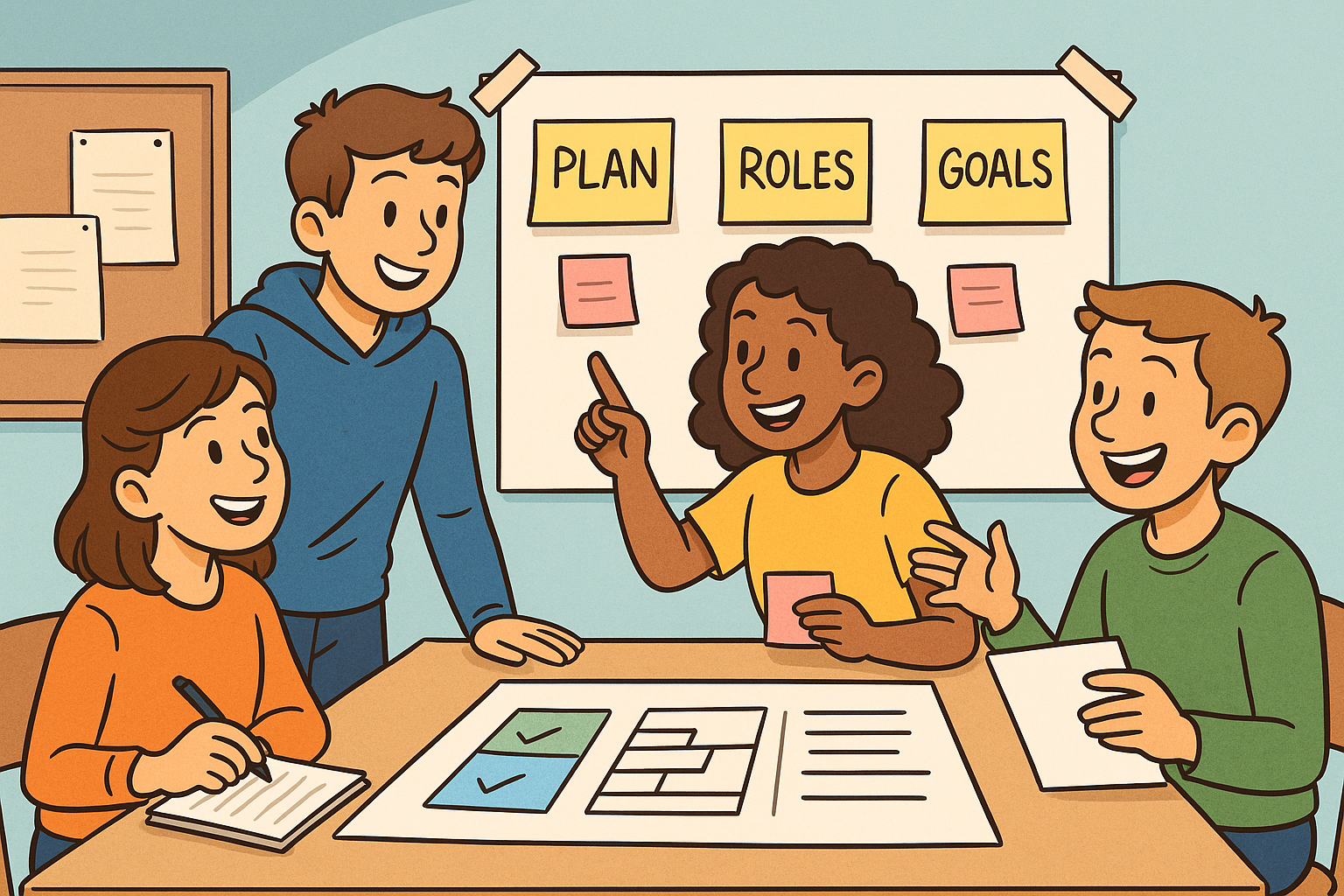🌟 Leadership & Teamwork for Teens
Have you ever been part of a group where one person made everyone feel motivated — not by shouting, but by listening, helping, and setting the tone?
That’s what real leadership looks like.
Leadership isn’t about power.
It’s about influence, responsibility, and connection.
🎯 What Leadership Really Means
Forget the idea that leaders are “the loud ones.”
Great leaders are the ones who:
- notice when others are struggling,
- help organize chaos into clarity,
- bring people together when things fall apart.
💬 “Leadership is making others better as a result of your presence — and making sure that impact lasts even when you’re gone.”
— Sheryl Sandberg (COO, Meta)

Real teamwork starts with clear roles and shared goals — every successful group begins with a plan.
🧩 The Three Types of Leaders
| Type | Description | Example |
|---|---|---|
| Commanding Leader | Gives direct orders and expects quick results. | Sports team captain shouting instructions. |
| Collaborative Leader | Encourages ideas and discussion. | Student who listens and organizes opinions. |
| Visionary Leader | Inspires with goals and long-term direction. | Classmate who helps everyone see the “why.” |
You don’t have to pick one — great leaders mix styles depending on the situation.
🧠 The Power of Listening
Most people think leadership = talking.
In truth, great leaders listen more than they speak.
Listening builds trust, which builds respect, which builds results.
Try it:
- Ask your teammate what they think.
- Repeat what you heard to confirm.
- Use their idea in your plan.
Instantly, the group feels ownership.

Active listening builds trust — when people feel heard, they become more open, creative, and cooperative.
⚙️ Teamwork Basics: The 5 Roles of a Strong Team
| Role | Focus | Example |
|---|---|---|
| Leader | Guides and organizes | Keeps group on track |
| Researcher | Finds data | Collects info for presentation |
| Creator | Designs or builds | Makes visuals or slides |
| Checker | Ensures quality | Reviews work for mistakes |
| Encourager | Keeps spirits high | Motivates, celebrates progress |
Every team needs a balance of all five.
If one is missing — the team struggles.
💬 Story: The Group That Fell Apart
In one school, five students were assigned a business project.
Two did all the work.
Two didn’t care.
One disappeared.
When the teacher asked why, one said:
“We didn’t know who was in charge or what to do.”
They didn’t fail because they were lazy — they failed because they lacked structure and leadership.

Without clear leadership or roles, even smart teams can get lost — structure turns chaos into collaboration.
🌱 How to Be a Leader Others Want to Follow
Leadership isn’t granted by title. It’s earned by actions.
Here’s what real leaders do:
-
Model the behavior you want.
If you’re calm, others stay calm. If you’re lazy, others stop trying. -
Share credit, own mistakes.
When something goes right — celebrate the team.
When something fails — take responsibility first. -
Be consistent.
People trust those who keep promises, even small ones. -
Ask questions, not orders.
“What do you think?” is more powerful than “Do this.”

True leadership means celebrating the team — sharing credit builds trust and respect that lasts beyond the project.
🧭 When Things Go Wrong
Even strong teams hit problems:
- Someone doesn’t show up.
- Deadlines slip.
- Arguments start.
A weak team blames.
A strong team fixes.
To reset:
- Call a short meeting.
- Let everyone speak once — no interruptions.
- Write one clear next step.
That’s leadership — not control, but coordination.
💡 Mini-Exercise: Your Team Map
Draw a small map with circles:
- You in the center
- Your teammates around
- Write 1 strength for each person
Now connect lines showing who supports who.
You’ll see patterns: leaders, helpers, and bridges.
Use that map to improve how you collaborate.
🧩 The Trust Formula
Trust = (Competence + Empathy) × Consistency
You can’t lead if people don’t trust you.
And you can’t build trust without showing both skill and care.
💬 “People don’t care how much you know until they know how much you care.” — Theodore Roosevelt

The Trust Formula: Competence + Empathy × Consistency — when people see skill, care, and reliability, they naturally follow your lead.
💬 Leadership in Action: The Silent Leader
At a student robotics event, one team member quietly kept track of time, checked battery levels, and reminded everyone of tasks.
He never gave orders.
Yet when asked who the leader was, everyone pointed to him.
Leadership isn’t about volume.
It’s about value.
🌍 Real-World Examples
- Malala Yousafzai – led change through courage, not command.
- Tim Cook (Apple) – calm, consistent, collaborative.
- Jacinda Ardern (NZ PM) – empathy + strength = trust.
Leadership has many forms — find yours.
🧠 Quick Team Check-In
When you’re in a team, ask:
- Is everyone clear about our goal?
- Does each person know their part?
- Are we respecting each other’s time and ideas?
If yes — you’re leading already.
💬 Remember:
Leadership is a practice, not a title.
You don’t wait to be chosen — you start by helping, and people follow naturally.
📝 Try this today
Think of a group you’ve worked in (school project, club, or sports team). Write what made it work well — or not.
Choose one small area (e.g., class duty or group chat). Try acting as a quiet leader for a week — listen, organize, encourage — without announcing it.
Make a simple list of your 3 strengths and 3 growth areas. Ask one friend to do the same and compare — how could you complement each other?
Lesson Progress
Module: acumen · +0% upon completion